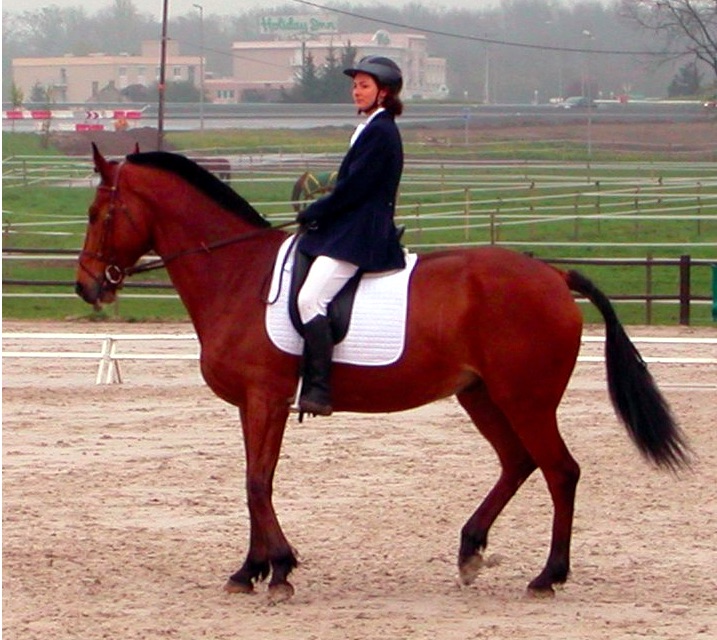|
Whether you're a dressage rider, hunter-jumper, eventer, or trail rider, you've probably been told that dressage will improve your riding and your horse. But is it true?
Here are some facts that may surprise you about the fate of dressage riders. A study published in 2010 reported the number of rides in dressage competitions in the U.S., broken out by level ridden:
So over half of dressage riders in the U.S. ride at Training and First Level. Why the drop off at 2nd Level? Do You Need a "Dressage Horse"? One conjecture is that 2nd level is the level at which collection is introduced, and the degree of collection that is rewarded in dressage contemporary competitions at 2nd level and beyond often exceeds the capabilities of the average horse. Instead, as riders progress through the levels, they often find they have to invest tens of thousands of dollars in purchasing a warmblood who essentially has been bred for the sport. Otherwise, they doom themselves to working hard simply to publicly humiliate themselves with mediocre scores. At that point, their hearts and their budgets demand that they simply give up. More importantly, many riders come to the sport of dressage not because they want to ride Grand Prix level but because they want to improve their own riding and their horse's way of going. They want to have something interesting to do with their horses that promotes the companionship they feel with their mounts (and their fellow riders) while enhancing the strength, agility, health, and (ultimately) longevity of both horse and rider. They believe dressage promises to help them achieve these ends. Looked at from this perspective, dressage in many riders' minds is more about human and equine fitness and sociality than competing to win ribbons. Dressage is indeed a way of improving any horse's strength, agility, and way of going. A well-trained dressage horse is a joy to ride. But are riders succeeding in achieving these ends? How are Dressage Riders Doing? The data reported in a very interesting article that appeared on centerlinescores.com suggests a deeper and more disturbing story behind the dropoff at 2nd level. From 2008 to 2012, the sport of dressage lost about 20,000 riders, and almost all of those who left were riding 2nd Level or below. While the economic downturn probably had something to do with this, the data show that almost all of those who dropped out were those who scored poorly at these levels. Most horses should be able to achieve the agility, flexibility, rhythm, and strength that are required to score well at Training and First Level. So the attrition at these levels suggests that something else is driving the loss of riders from the sport of dressage. I think the answer can be found in dressage discussion sites. The majority of text and video posts on these sites are from people who are unhappy with their test scores and are looking for help. The problems apparent in their riding almost always boil down to two things:
Without these fundamentals in place, it is impossible to progress through even Training Level. Most of the riders who post are taking dressage lessons, but it is apparent that they don't understand what their trainers are telling them to do. So they turn to discussion sites hoping to get some useful feedback on their riding that will help them improve. The responses they get vary wildly from the unhelpful "blind leading the blind" (people who don't ride well themselves but are free with their advice), to cheerleading ("Super! You look great! Keep up the good work!), to advanced riders and trainers who write responses that are for the most part incomprehensible to the riders who posted ("Your horse needs more impulsion in his gait. Use your leg aids to engage his hindquarters more. Shoulder-fore and counter-canter will also help straighten him.") Even more troubling is that trainers are usually forbidden to post links to their own articles, videos, or books in response to queries even though this would undoubtedly inject quality instruction into the discussion. This is frowned upon as "self-promotion." Policies like this almost guarantee that the advice received will be of dubious quality. How to Use This Site to Improve Your Riding The blog posts on this site are intended to offer useful advice in plain English to help you improve your riding (and your understanding of horses) whether you are a dressage rider, hunter-jumper, eventer, or trail rider. Most of the articles contain videos (including slow-motion videos) that demonstrate clearly what the rider is doing to influence her horse's movement. No matter which discipline or level you ride, start with this article on how to develop a secure seat that allows you the freedom to use your leg and rein aids in even the most advanced movements. Then move on to this article about how to improve your rein contact so that it is the kind of elastic, "live" contact that horses willingly accept. With these cornerstones in place, move on to the many articles on how to ride more advanced movements such as shoulder-fore, shoulder-in, travers, renvers, and half-pass. If you ride hunter/jumper or eventing, be sure to read these articles on using dressage to control your horse's speed on a jump course, and how to master the automatic release. (I encourage dressage and trail riders to jump their horses as well. You have no idea how much fun it is for both humans and horses.) When you have mastered these, your horse will be strong, cooperative, and agile. And you will ride with style, harmony, and confidence. Happy riding! Copyright Denise Cummins March 20, 2016 Photo Credit: https://upload.wikimedia.org/wikipedia/commons/7/71/Horse_riding_left.jpg
1 Comment
|
AuthorDenise Cummins is a research psychologist and former dressage/jumping instructor, trainer, and equestrian facility owner. ArchivesCategories |

 RSS Feed
RSS Feed